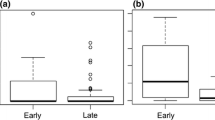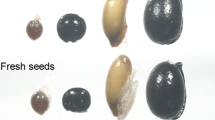Abstract
The Japanese pavement ant Tetramorium tsushimae Emery (Formicidae) is a species of seed-collecting ant found in Japan. However, its role in seed dispersal has not yet been satisfactorily documented. We investigated the seed-carrying behaviour of T. tsushimae both in the laboratory and in the field. In the laboratory, seeds of three common weeds [evening primrose Oenothera biennis (Onagraceae), purslane Portulaca oleracea (Portulacaceae), and dropseed Sporobolus fertilis (Poaceae)] were examined. More than 65% of each kind of seed was carried by the ants, but some were later discarded outside the nest. Among the three, S. fertilis seeds were collected most frequently. The germination rate of the seeds was higher than 80% for both discarded and stored O. biennis and S. fertilis seeds but lower than half for discarded P. oleracea seeds. In the field, the relationship between the ants and the growing locations of O. biennis or P. oleracea was investigated. The distribution of O. biennis plants considerably overlapped with the distribution of T. tsushimae nest holes at all survey sites. The distribution of P. oleracea also overlapped with that of ant nest holes at some sites. In areas where O. biennis and P. oleracea were absent, a high proportion (> 65%) of artificially placed seeds were carried by T. tsushimae. A few months later, O. biennis seedlings were observed near many ant nest holes. The mean distance between the seedlings and seed-set point was 7.2 m. Although P. oleracea seeds were observed near nest holes, their seedlings were not detected. The present results suggest that O. biennis plants benefit from seed dispersal by T. tsushimae and that the distribution of P. oleracea plants might also be influenced by ant foraging behaviour.




Similar content being viewed by others
References
Abe T (1971) On the food sharing among four species of ants in a sandy grassland. I. Food and foraging behaviour. Jpn J Ecol 20:219–230 (in Japanese with English abstr.)
Aliotta G, Cafiero G, Otero AM (2006) Weed germination, seedling growth and their lesson for allelopathy in agriculture. In: Reigosa MJ, Pedrol N, González L (eds) Allelopathy: a physiological process with ecological implications. Springer, Dordrecht, pp 285–297
Andersen AN (1988) Dispersal distance as a benefit of myrmecochory. Oecologia 75:507–511
Andersen AN (1991) Seed harvesting by ants in Australia. In: Huxley CR, Cutler DF (eds) Ant–plant interaction. Oxford University Press, Oxford, pp 493–503
Ashton DH (1979) Seed harvesting by ants in forests of Eucalyptus regnans F. Muell. in central Victoria. Austral Ecol 4:265–277
Beattie AJ (1983) Distribution of ant-dispersed plants. In: Kubitzki K (ed) Dispersal and distribution, an international symposium, vol 7. Sonderbd Naturwiss Ver Hamburg, Hamburg, pp 249–270
Beattie AJ (1985) The evolutionary ecology of ant–plant mutualisms. Cambridge University Press, Cambridge
Beattie AJ, Culver DC (1981) The guild of myrmecochores in the herbaceous flora of West Virginia forests. Ecology 62:107–115
Bianchini M, Lisci M, Pacini E (1994) What are the functions of the elaiosome? Plant Biosyst 128:221
Brew CR, O’Dowd DJ, Rae ID (1989) Seed dispersal by ants: behaviour-releasing compounds in elaiosomes. Oecologia 80:490–497
Camargo PHSA, Martins MM, Feitosa RM, Christianini AV (2016) Bird and ant synergy increases the seed dispersal effectiveness of an ornithochoric shrub. Oecologia 181:507–518
Farji-Brener AG, Ghermandi L (2008) Leaf-cutting ant nests near roads increase fitness of exotic plant species in natural protected areas. Proc R Soc B 275:1431–1440
Gaddy LL (1986) Twelve new ant-dispersed species from the southern Appalachians. Bull Torrey Bot Club 113:247–251
Gómez C, Espadaler X (1998) Seed dispersal curve of a Mediterranean myrmecochore: influence of ant size and the distance to nests. Ecol Res 13:347–354
Gómez C, Espadaler X (2013) An update of the world survey of myrmecochorous dispersal distances. Ecography 36:1193–1201
Gómez C, Espadaler X, Bas JM (2005) Ant behaviour and seed morphology: a missing link of myrmecochory. Oecologia 146:244–246
Handel SN, Fisch SB, Schatz GE (1981) Ants disperse a majority of herbs in a mesic forest community in New York State. Bull Torrey Bot Club 108:430–437
Higashi S, Tsuyuzaki S, Ohara M, Ito F (1989) Adaptive advantages of ant-dispersed seeds in the myrmecochorous plant Trillium tschonoskii (Liliaceae). Oikos 54:389–394
Hölldobler B, Wilson EO (1990) The harvesting ants. In: The ants. Harvard University Press, Cambridge, pp 609–617
Hudson BJF (1984) Evening primrose (Oenothera spp.) oil and seed. J Am Oil Chem Soc 61:540–543
Hughes L, Westoby M (1992) Fate of seeds adapted for dispersal by ants in Australian sclerophyll vegetation. Ecology 73:1285–1299
Johnson RA (2001) Biogeography and community structure of North American seed-harvester ants. Annu Rev Entomol 46:1–29
Leal IR, Wirth R, Tabarelli M (2007) Seed dispersal by ants in the semi-arid Caatinga of north-east Brazil. Ann Bot 99:885–894
Lengyel S, Gove AD, Latimer AM, Majer JD, Dunn RR (2010) Convergent evolution of seed dispersal by ants, and phylogeny and biogeography in flowering plants: a global survey. Perspect Plant Ecol 12:43–55
Levey DJ, Byrne MM (1993) Complex ant–plant interactions: rain-forest ants as secondary dispersers and post-dispersal seed predators. Ecology 74:1802–1812
Li Vigni I, Melati MR (1999) Examples of seed dispersal by entomochory. Acta Bot Gallica 146:145–156
Mittelbach GG, Gross KL (1984) Experimental studies of seed predation in old-fields. Oecologia 65:7–13
Miura R, Doi M, Yoshino M (2003) Distribution and myrmecochory of Veronica polita subsp. lilacina observed in the area around Kyoto University. J Weed Sci Tech 48:140–142 (in Japanese)
Nakanishi H (1988) Myrmecochores in warm-temperate zone of Japan. Jpn J Ecol 38:169–176 (in Japanese with English abstr.)
Noguchi K, Nakayama K, Ban CD (1973) Studies on ecological characteristics of common purslane. 1. On the germination of the seed and growth at early stage. J Weed Sci Technol 15:65–69 (in Japanese with English abstr.)
O’Dowd DJ, Hay ME (1980) Mutualism between harvester ants and a desert ephemeral: seed escape from rodents. Ecology 61:531–540
Ohara M, Higashi S (1987) Interference by ground beetles with the dispersal by ants of seeds of Trillium species (Liliaceae). J Ecol 75:1091–1098
Ohkawara K, Ohara M, Higashi S (1997) The evolution of ant-dispersal in a spring-ephemeral Corydalis ambigua (Papaveraceae): timing of seed-fall and effects of ants and ground beetles. Ecography 20:217–223
Ohnishi YK, Suzuki N (2009) Preferential removal of non-injured seeds by an omnivorous ant, Tetramorium tsushimae Emery, in the seed dispersal of Chamaesyce maculata (L.) small. Ecol Res 24:1155–1160
Ohnishi Y, Suzuki N, Katayama N, Teranishi S (2008) Seasonally different modes of seed dispersal in the prostrate annual, Chamaesyce maculata (L.) small (Euphorbiaceae), with multiple overlapping generations. Ecol Res 23:299–305
Ohnishi YK, Katayama N, Suzuki N (2013) Differential dispersal of Chamaesyce maculata seeds by two ant species in Japan. Plant Ecol 214:907–915
Oliveras J, Gómez C, Bas JM, Espadaler X (2008) Mechanical defence in seeds to avoid predation by a granivorous ant. Naturwissenschaften 95:501–506
Oostermeijer JGB (1989) Myrmecochory in Polygala vulgaris L., Luzula campestris (L.) DC. and Viola curtisii Forster in a Dutch dune area. Oecologia 78:302–311
Pascov CM, Nevill PG, Elliott CP, Majer JD, Anthony JM, Krauss SL (2015) The critical role of ants in the extensive dispersal of Acacia seeds revealed by genetic parentage assignment. Oecologia 179:1123–1134
Passos L, Oliveira PS (2002) Ants affect the distribution and performance of seedlings of Clusia criuva, a primarily bird-dispersed rain forest tree. J Ecol 90:517–528
Retana J, Xavier Pico F, Rodrigo A (2004) Dual role of harvesting ants as seed predators and dispersers of a non-myrmechorous Mediterranean perennial herb. Oikos 105:377–385
Rissing SW (1986) Indirect effects of granivory by harvester ants: plant species composition and reproductive increase near ant nests. Oecologia 68:231–234
Ryan TA (1960) Significance tests for multiple comparisons of proportions, variances, and other statistics. Psychol Bull 57:318–328
Sakuratani Y (1996) Wild birds observed on the Nara campus of Kinki University. Mem Fac Agric Kinki Univ 29:27–37 (in Japanese with English abstr.)
Sernander R (1906) Entwurf einer monographie der europäischen myrmecochoren. Kunglica Sven Vetensk Handl 41:1–410
Shimizu T (2003) Naturalized plants of Japan. Heibonsha Ltd. Publishers, Tokyo (in Japanese)
Suetsugu K (2015) Seed dispersal of the hemiparasitic plant Thesium chinense by Tetramorium tsushimae and Pristomyrmex punctatus. Entomol Sci 18:523–526
Syokyu N, Nakata N, Kuwazuka N, Ohashi H (1976) Cultivation and breeding of Oenothera-plant. VIII. Effect of seeding time on growth, development and components in seed of Oenothera biennis. Jpn J Pharmacognosy 30:52–57 (in Japanese with English abstr.)
Terayama M, Kubota S (2009) The handbook of ants. Bun-ichi Co., Ltd., Tokyo (in Japanese)
Whitney KD (2002) Dispersal for distance? Acacia ligulata seeds and meat ants Iridomyrmex viridiaeneus. Austral Ecol 27:589–595
Acknowledgements
We thank I. Kuroki and H. Mukai for collecting literature. This work was supported in part by Research Fellowships from the Japan Society for the Promotion of Science (JSPS) for Young Scientists (18K19353) to AY.
Author information
Authors and Affiliations
Corresponding author
Additional information
Handling Editor: Jouni Sorvari.
Publisher's Note
Springer Nature remains neutral with regard to jurisdictional claims in published maps and institutional affiliations.
Rights and permissions
About this article
Cite this article
Ohtsuka, S., Hada, Y., Nakamura, K. et al. Seed dispersal by the omnivorous ant Tetramorium tsushimae Emery (Formicidae) in three common weed species. Arthropod-Plant Interactions 14, 251–261 (2020). https://doi.org/10.1007/s11829-019-09734-8
Received:
Accepted:
Published:
Issue Date:
DOI: https://doi.org/10.1007/s11829-019-09734-8




